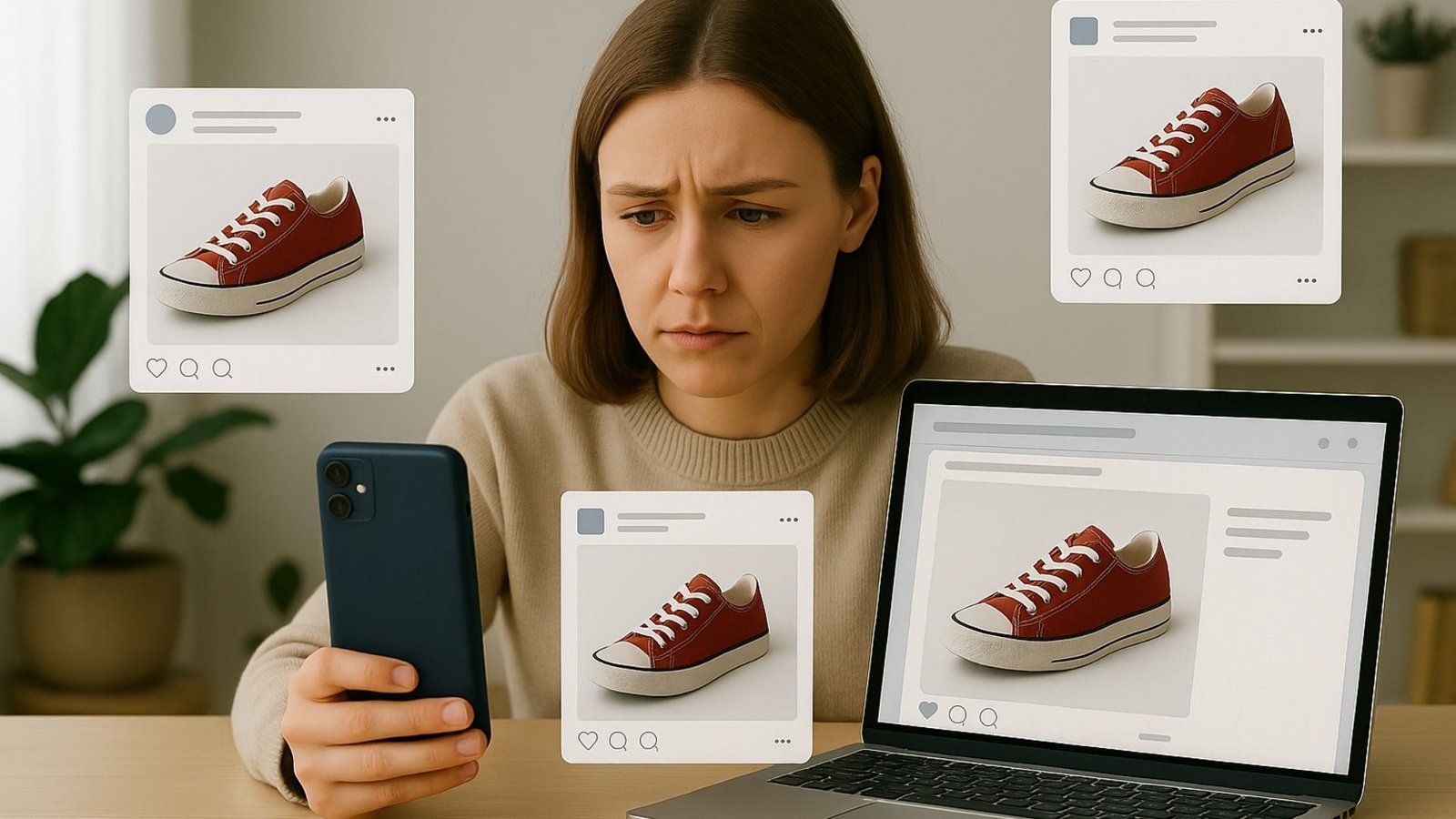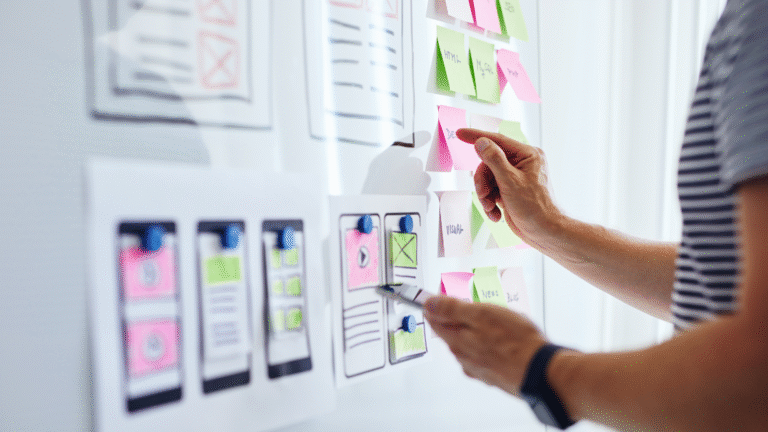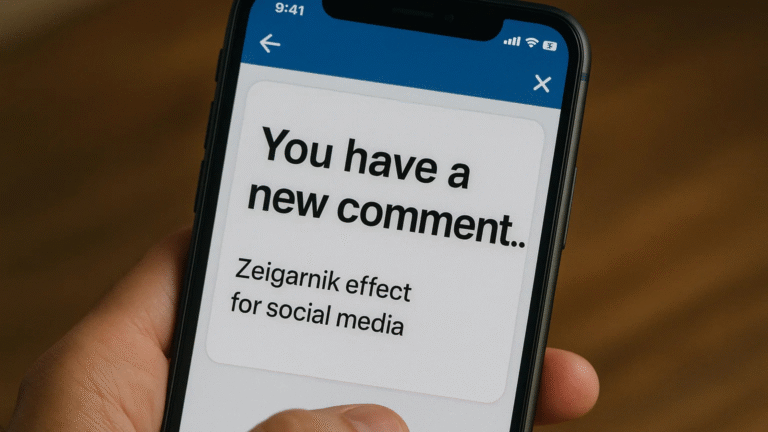Have you ever experienced The Baader-Meinhof Phenomenon where something new you just learned suddenly starts appearing everywhere?
It’s not a coincidence.
It’s called the Baader-Meinhof Phenomenon, also known as the frequency illusion, and it’s one of the most powerful psychological effects you can tap into as a marketer.
But how exactly does it work, and how can digital marketing agencies and small businesses use it in social campaigns?
Let’s dive into this fascinating phenomenon and explore how you can strategically apply it to boost visibility, build brand familiarity, and drive conversions all while staying authentic and ethical.
What Is the Baader-Meinhof Phenomenon?
The Baader-Meinhof Phenomenon also widely known as frequency illusion is a cognitive bias that causes people to notice something repeatedly after first learning about it.
Despite appearing to be a sudden increase in occurrence, it’s actually a shift in perception.
The item, word, idea, or concept has likely been present all along, but your brain is only now recognizing and focusing on it because it has been “activated” in your awareness.
Origin of the Term
Interestingly, the term “Baader-Meinhof” has nothing to do with psychology or neuroscience.
It was coined in 1994 on an internet forum when someone noticed they had heard about the German terrorist group “Baader-Meinhof” twice in a short span of time and joked about how oddly frequent the term had become.
Since then, the name stuck even though the more scientific label is frequency illusion, a term coined by Arnold Zwicky, a linguist at Stanford University.
The Psychology Behind It
The Baader-Meinhof Phenomenon arises due to two key psychological mechanisms:
1. Selective Attention
This is your brain’s ability to focus on certain stimuli while ignoring others.
Once you encounter something new or meaningful, your brain begins to subconsciously scan for similar cues.
It gives that item a kind of “mental spotlight,” making you notice it more often in the world around you.
2. Confirmation Bias
Once you’ve noticed something once or twice, your brain begins to expect to see it again.
When it appears again, you interpret this as confirmation that it’s suddenly showing up more when in fact, it was always there.
This reinforcement makes the illusion feel even stronger.
Combined, these effects create a loop: awareness leads to observation, which leads to perceived frequency, which reinforces awareness again.
This isn’t because those things have suddenly become more common it’s because your brain has been tuned to notice them.
How It Relates to Information Overload
In today’s digital age, we’re exposed to thousands of pieces of content per day. Our brains can’t consciously process all of it.
So we rely on heuristics shortcuts in our thinking that determine what stands out.
When something becomes relevant to you (through personal experience, curiosity, or exposure), your brain prioritizes that information.
That’s why The Baader-Meinhof Phenomenon is especially powerful in digital marketing, advertising, and brand recall.
It allows marketers to work with the brain’s natural filtering system to amplify perception ethically.
How The Baader-Meinhof Phenomenon Works?
To understand how The Baader-Meinhof Phenomenon works, we need to look at both psychology and perception.
It’s not that something new suddenly floods your environment.
The reality is that your brain changes how it filters information once it encounters something for the first time.
This shift combines two powerful mental processes: selective attention and confirmation bias.
1. Selective Attention
Humans are constantly bombarded with stimuli thousands of images, sounds, and words compete for our attention every second.
To avoid overload, the brain filters most of it out. However, once you become aware of a new concept, brand, or word, it slips through that filter and lands on your “priority list.”
- For example, if you just learned the term influencer marketing, your brain subconsciously starts scanning for it in social feeds, ads, and conversations.
- It’s not that influencer marketing posts suddenly increased; it’s that you’ve primed yourself to notice them.
This is the first layer of the frequency illusion.
2. Confirmation Bias
The second process is confirmation bias the tendency to interpret and remember things in ways that support what you already know or believe.
Once your brain has flagged something as relevant, each repeated encounter reinforces the belief that it’s “everywhere.”
- You’ll notice posts, ads, or mentions that confirm its presence.
- At the same time, your brain conveniently ignores countless other things that don’t feel relevant to your new awareness.
This combination creates the illusion of frequency a heightened perception of something’s presence, even if it’s not statistically more common.
3. The Cycle of Reinforcement
Here’s why The Baader-Meinhof Phenomenon feels so powerful:
- First exposure: You notice something new.
- Mental filter activation: Your brain begins searching for it unconsciously.
- Reinforcement: Every new encounter confirms your belief that it’s common.
- Memory strengthening: With each repeat exposure, your recall gets stronger.
This cycle turns what could have been a passing detail into a memorable, recurring signal.
4. Why It’s So Effective in Marketing
For marketers, this cycle is golden. Once a potential customer sees your brand or message for the first time, every subsequent sighting (on Instagram, YouTube, blogs, or email) doesn’t feel like “another ad.”
It feels like proof that your brand is relevant and important.
That’s why repetition across multiple channels when done strategically can:
- Boost trust
- Improve recall
- Create the perception that “everyone is talking about you”
- Shorten the time between discovery and purchase
5. The Brain’s Shortcut to Familiarity
Psychologists call this processing fluency: the more often we encounter something, the easier it is for our brain to process it.
And when something feels easy to process, it feels familiar and safe. That’s why logos, taglines, and repeated ad messages become anchors in a consumer’s mind.
In short, The Baader-Meinhof Phenomenon works because your brain isn’t a neutral observer it’s a biased filter looking for shortcuts.
Marketers who understand this can design campaigns that align with how the brain naturally processes information.
Why Does It Matters in Marketing?
The Baader-Meinhof Phenomenon is not just a curiosity of the brain it’s a powerful psychological lever in modern marketing.
When used intentionally, it can drastically improve how your audience perceives your brand, message, or product. Here’s why:
1. It Builds Rapid Brand Familiarity
The more frequently people see or hear about your brand even if they’re not consciously engaging the more familiar it becomes. Familiarity breeds trust.
This is critical in industries where brand choice is overwhelming and competition is high.
If someone sees your content across platforms a few times, their brain begins to flag you as “established,” even if you’re new.
Example: A small skincare brand might only have a few hundred followers, but if it shows up on Instagram, TikTok, YouTube Shorts, and Google Ads with the same message, the viewer starts believing it’s popular.
2. It Reduces Buyer Hesitation
People are hesitant to try new products or services. The Baader-Meinhof Phenomenon helps bridge that trust gap.
When potential customers feel like they’re “seeing you everywhere,” they become more comfortable and likely to convert.
This is particularly effective for digital marketing agencies and small businesses, where budget limitations make high-volume reach difficult. Strategic repetition is the shortcut.
3. It Supports Omnichannel Strategy
Frequency illusion validates the importance of omnichannel marketing.
When users encounter your message across email, social media, blog content, remarketing ads, and influencer partnerships, they begin associating your brand with relevance and credibility.
Even if the messaging varies in format or tone, the theme and branding trigger recognition and psychological consistency.
4. It Feeds the Funnel Without Feeling Pushy
Unlike intrusive ads or cold messages, frequency illusion allows you to “follow” the consumer in a subtle, non-invasive way.
Your content shows up repeatedly but in different formats, on different platforms, with different value angles.
This is especially important for top-of-funnel awareness strategies where the goal is not instant conversion, but repeated exposure that leads to eventual engagement.
5. It Multiplies Content ROI
By designing campaigns around The Baader-Meinhof Phenomenon, you get more from every content piece.
A single blog post can be repurposed into quotes for social media, short videos, carousels, and email snippets all reinforcing the same message.
Socinova Pro Tip: Instead of chasing trends every day, reinforce your core brand narrative across assets. Let frequency illusion do the heavy lifting.
In short, The Baader-Meinhof Phenomenon works in marketing because it mirrors how our brains naturally form trust through repeated exposure to familiar, consistent signals.
When your brand becomes part of someone’s environment, it becomes part of their decision-making.
The Science Behind Frequency Illusion
The Baader-Meinhof Phenomenon, or frequency illusion, is a cognitive bias where something newly noticed like a product or brand suddenly feels like it’s everywhere.
This isn’t due to increased frequency, but rather your brain’s heightened sensitivity to it.
Two key mechanisms power this: selective attention, which focuses your awareness on what feels newly relevant, and confirmation bias, which reinforces the belief that it’s appearing more often. Together, they create a loop that boosts perceived frequency.
Add in processing fluency our brain’s preference for familiar information and repetition becomes a trust signal.
Neuroscience shows that repeated exposure helps move information from short-term to long-term memory, making it easier to recall and act on.
From an evolutionary lens, our brains are wired to spot patterns.
So in marketing, repeated brand exposure triggers relevance and trust. Importantly, this isn’t passive your audience’s brain is filtering for what feels familiar.
That’s why a memorable first touchpoint, followed by consistent reinforcement, is so powerful.
Practical Applications of The Baader-Meinhof Phenomenon in Social Campaigns
Understanding The Baader-Meinhof Phenomenon is just the first step.
The real power lies in applying it strategically to your social media campaigns to maximize visibility, trust, and conversions.
When you align your content strategy with this psychological principle, you allow your audience’s brain to do the heavy lifting: spotting, remembering, and reinforcing your message across platforms.
Here’s how digital marketers and small businesses can practically use frequency illusion to drive consistent brand recognition:
1. Consistent Brand Messaging Across Platforms
The first rule of frequency illusion is consistency.
When a user sees your message, tone, and branding repeatedly in different contexts LinkedIn, Instagram, Facebook, email they begin to associate your business with credibility and professionalism.
- Use a unified visual identity: same logo, colors, fonts.
- Align your messaging: repeat the same core benefits and brand promise in different posts.
- Adapt the format, not the theme: A blog post on Instagram becomes a carousel, a quote on Twitter, and a Reel on YouTube Shorts but the idea stays consistent.
Socinova Tip: Use content calendars and templates to maintain visual and thematic consistency across all client accounts.
2. Strategic Retargeting Campaigns
Retargeting is perhaps the most literal and measurable application of The Baader-Meinhof Phenomenon.
When someone visits your website or engages with a post, you can follow up with ads that appear on their Facebook, Instagram, Google Display Network, or even YouTube.
This triggers the illusion that your brand is suddenly everywhere, when in fact you’re simply showing up where they already are.
- Retarget website visitors with educational content or testimonials.
- Segment audiences for deeper personalization.
- Show familiar visuals or phrases from their previous interaction.
Budget tip: Even a $50/month retargeting budget can go a long way when paired with organic content that primes your audience.
3. Thematic Content Repurposing
Repetition doesn’t have to mean redundancy. Instead of copying the same post across channels, repurpose your content around the same core theme using different formats and angles.
Example for a wellness brand:
- Instagram Carousel: “5 Benefits of Daily Meditation”
- Facebook Post: Client testimonial on reduced stress
- YouTube Short: Quick breathing technique
- Blog: “The Science Behind Meditation and Mental Clarity”
All of these pieces trigger familiarity. Your audience begins to see you as a consistent thought leader on the topic.
Socinova Advantage: We offer a content repurposing service that transforms a single post into 5+ platform-ready pieces all aligned to reinforce frequency illusion.
4. Influencer & UGC Collaboration Waves
Another powerful way to simulate the illusion of frequency is by coordinating influencer mentions or UGC (User-Generated Content) around the same period.
When your audience sees three influencers talking about your brand within a short window on different platforms it feels like your product or service is trending.
- Work with micro-influencers who have trust within niche communities.
- Provide branded templates or talking points for message consistency.
- Launch short “buzz windows” instead of long, staggered campaigns.
Pro Insight: Micro-influencer clusters often perform better than single macro accounts when aiming to activate frequency illusion.
5. Email Flows that Reinforce Key Messages
Frequency illusion also applies to email marketing. Sending a well-structured sequence of emails over days or weeks reinforces your core value proposition subtly and repeatedly.
Example:
- Day 1: Welcome email with brand story
- Day 3: Educational tip aligned with your solution
- Day 5: Case study or testimonial
- Day 7: Offer or CTA
The reader begins to expect your emails and starts seeing your brand as a trusted expert.
Socinova Email Services: We can design nurture flows that align with your social media content to deliver multi-touchpoint consistency.
6. Use Hashtags and Keywords Repetitively
Repetition in language also matters.
When users frequently see the same hashtags or keywords (like #ZeroTaxSolution, #SustainableDesign, or #BackPainRelief), they subconsciously start associating those terms with your brand.
Don’t overdo it, but make sure your most important keywords and brand hashtags appear consistently across your posts, bio, videos, and even comments.
SEO Crossover: Use the same principle in blogs, landing pages, and Google My Business posts to sync on-page and off-page brand perception.
7. Storytelling Anchored Around a Core Identity
Instead of changing your messaging every week, anchor it to a single story, belief, or transformation promise.
This repeated narrative creates identity-based memory.
Example for a fitness coach:
- “I help busy professionals lose 10 lbs in 8 weeks without giving up their favorite food.”
Now tell different parts of this story across platforms, testimonials, and ads.
Socinova Strategy Layer: We help brands craft a signature story and weave it across campaigns activating the illusion of a strong, ever-present brand.
Real-Life Examples of Frequency Illusion in Marketing
Understanding The Baader-Meinhof Phenomenon is one thing seeing it in action is another.
Some of the most powerful global brands have leveraged frequency illusion to dominate mindshare and convert casual exposure into loyal consumer behavior.
Let’s explore a few stand-out examples:
Disney: The Original Master of Frequency Illusion
If you’re a parent, you know that Disney is hard to miss. That’s by design.
Since Mickey Mouse’s debut in 1928, Disney has intentionally built emotional familiarity through sheer repetition.
- Mickey appears in shows, toys, books, clothes, theme parks, and more.
- Every exposure reinforces the association between childhood joy and Disney’s brand identity.
- This isn’t just nostalgia it’s brand engineering using frequency illusion at a generational scale.
The more you see Mickey, the stronger the connection becomes.
Disney doesn’t rely on surprise they rely on strategic, consistent repetition to drive brand association and loyalty.
The takeaway: Emotional brand reinforcement thrives on consistency over time, not just momentary buzz.
Amazon: Repetition That Builds Trust
Every time you browse Amazon, you likely notice that specific products keep reappearing across different pages homepage banners, sponsored ads, related product carousels, and even follow-up emails.
It’s not random; it’s strategic.
This persistent exposure taps directly into The Baader-Meinhof Phenomenon, making products feel more popular, more relevant, and more trustworthy.
As frequency increases, resistance lowers. Eventually, the repeated visibility leads to curiosity and often, a purchase.
The takeaway: Repetition across your own ecosystem (website, emails, app, etc.) can be just as powerful as external advertising.
Prime: Ubiquity Creates Believability
Logan Paul and KSI’s energy drink brand, Prime, is one of the best modern examples of frequency illusion done right.
In its very first year, Prime raked in over $250 million in retail sales, largely due to an aggressive omnipresence strategy.
From social media takeovers and viral videos to in-store shelf dominance and sports sponsorships, Prime was everywhere.
The Baader-Meinhof effect kicked in hard: once a customer saw Prime once, they kept noticing it on Instagram, in YouTube vlogs, on store shelves, and in influencer conversations.
This repetitive visibility made Prime feel like the drink “everyone is talking about,” catapulting it to household-name status.
The takeaway: Saturate visibility quickly and across diverse touchpoints to fast-track consumer belief and trust.
How Small Businesses Can Use This Baader-Meinhof Phenomenon Without Big Budgets?
You don’t need a massive media budget to use The Baader-Meinhof Phenomenon. Here’s how small brands can leverage it effectively:
- Post similar messaging across 3 platforms every week
- Repurpose blogs into carousels, reels, and infographics
- Set up Facebook or Google remarketing ads with a $50/month budget
- Partner with 3 micro-influencers in your niche
- Use storytelling to reinforce your brand’s values
Socinova Tip: Use scheduling tools to stay consistent with posts across platforms.
Psychological Benefits for Your Audience
- Familiarity: Repeated exposure makes your brand feel recognizable and safe.
- Trust: Consistency builds credibility and reduces perceived risk.
- Relevance: Frequent appearances reinforce the idea that your brand is important and timely.
- Confidence in Decision-Making: When they keep seeing your brand, buyers feel more secure about choosing you.
- Emotional Connection: Repetition tied to positive messaging forms deeper emotional associations.
- Reduced Cognitive Load: Familiar brands require less mental effort to process, making decisions easier.
- Sense of Belonging: When your brand is visible in communities or trends, users feel part of something larger.
Mistakes to Avoid While Using This Phenomenon
- Being Too Repetitive: If every post is the same, you’ll bore your audience. The trick is theme-based repetition, not copy-paste monotony.
- Neglecting Platform-Specific Context: What works on Instagram might not work on LinkedIn. Customize while keeping the core consistent.
- Ignoring Analytics: Track what repetition is working and what’s not. Not every message needs repeating.
Why Does Socinova Uses This in Every Strategy?
At Socinova, we don’t rely on luck to make your brand memorable we apply proven psychological principles like The Baader-Meinhof Phenomenon in every marketing strategy.
We understand that frequency illusion isn’t about spamming your audience, but about creating strategic, repeated exposure across platforms that feels natural and reinforces trust.
Whether it’s through consistent social media posting, retargeting ads, email flows, or influencer collaborations, we ensure your brand shows up where your audience already is again and again.
This repeated visibility builds familiarity, which builds confidence, which ultimately leads to conversions.
From startups to established businesses, we use this phenomenon to craft omnipresent brand experiences that stick.
When you work with Socinova, you’re not just showing up you’re staying top of mind.
Final Thoughts
The Baader-Meinhof Phenomenon isn’t just an interesting psychological quirk it’s a game-changing strategy for marketers who want to build lasting brand recognition.
By understanding how selective attention and confirmation bias shape consumer perception, businesses can create marketing campaigns that feel natural, familiar, and trustworthy.
You don’t need a massive budget or viral content to make your brand unforgettable.
You just need consistency, strategic repetition, and a presence across the platforms your audience already uses.
Whether it’s a repurposed blog post, a retargeting ad, or a coordinated influencer mention, each exposure adds up helping your brand feel “everywhere” without being overwhelming.
At Socinova, we specialize in making this phenomenon work for startups and small businesses.
We help you create content systems that align with how the brain works boosting recall, trust, and conversions in an organic way.
Ready to become the brand your audience can’t stop noticing? Let Socinova help you show up where it matters again and again.
FAQs
Q: Is it ethical to use the Baader-Meinhof effect in marketing?
A: Yes, if used responsibly. The goal is to reinforce helpful, relevant messages that actually serve your audience.
Q: How many touchpoints does it take to trigger the phenomenon?
A: Usually 3 to 7 touchpoints across platforms work well, depending on the audience and product.
Q: Can it backfire?
A: Yes, if your content becomes too repetitive or irrelevant. Track user engagement and adjust.
Written by Priyanka Velhal from Socinova.




